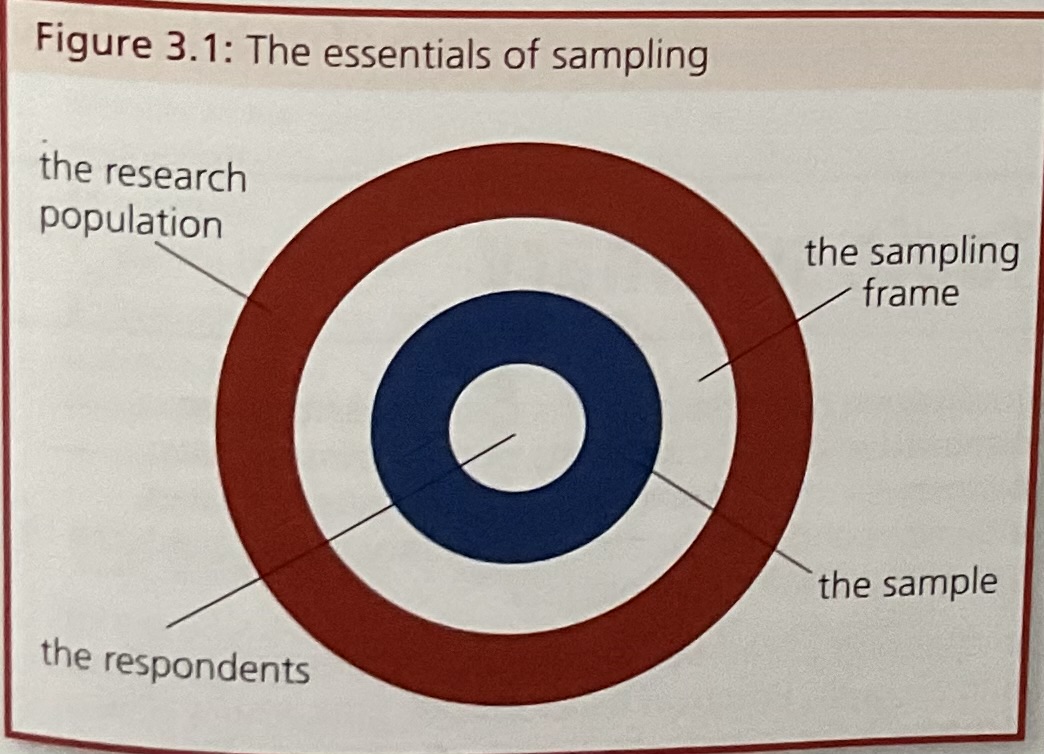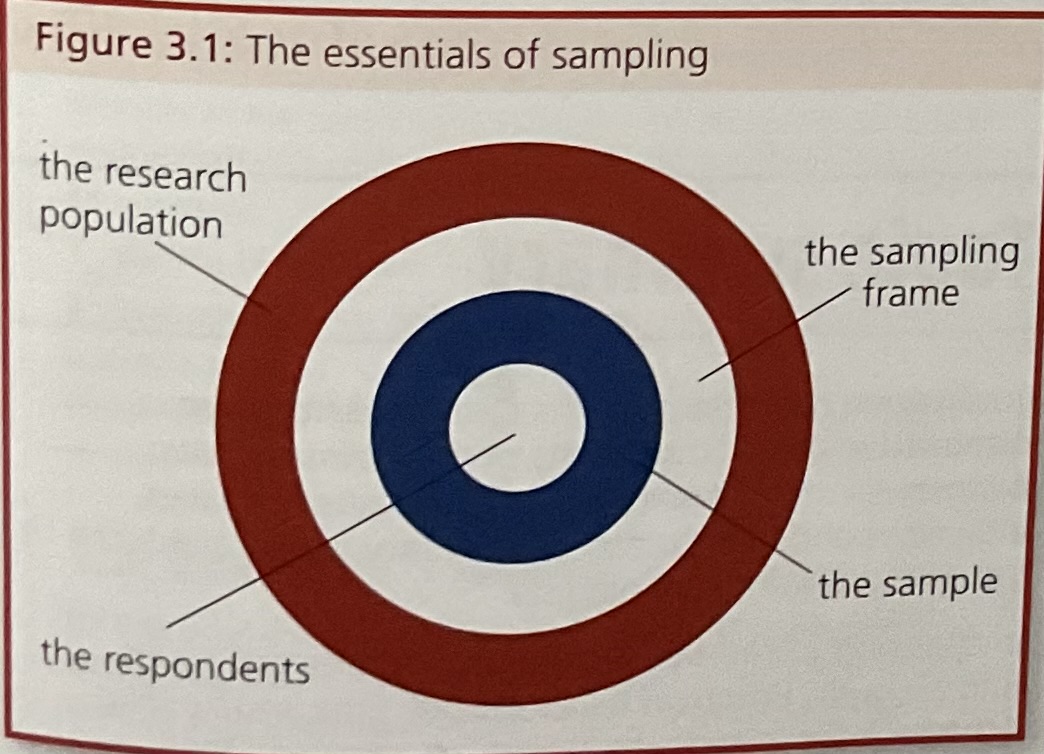process of research - sampling
1/17
There's no tags or description
Looks like no tags are added yet.
Name | Mastery | Learn | Test | Matching | Spaced |
|---|
No study sessions yet.
18 Terms
Sociologists often aim to produce g____ that apply to all cases of the topic they are interested in.
For example, if we were interested in educational achievement, we would ideally want our theory to explain the achievement levels of a____ pupils, not just who
, however, we do not have the t____ or m____ to do what , so we have to choose a s_____ of pupils to include.
Sociologists often aim to produce generalisations that apply to all cases of the topic they are interested in.
For example, if we were interested in educational achievement, we would ideally want our theory to explain the achievement levels of all pupils, not just the ones who were in our study.
, however, we do not have the time or money to include every pupil in the UK in our study, so we have to choose a sample of pupils to include.
what is a sample
A sample is a smaller sub-group drawn from the wider group that we are interested in.
The basic purpose of sampling is usually to ensure that those people we have chosen to include in the study (such as pupils) are r___ or typical of the research population, including the people not included in the study.
The research population refers to what
The basic purpose of sampling is usually to ensure that those people we have chosen to include in the study (such as pupils) are representative or typical of the research population, including the people not included in the study.
The research population refers to the whole group that we are interested in - all pupils, in this case.
So long as our sample is representative, we should be able to do what
This is particularly attractive to what type of sociologists and why
So long as our sample is representative, we should be able to generalise our findings to the whole research population.
This is particularly attractive to positivist sociologists, who wish to make general, law-like statements about the wider social structure.
The sampling frame
To choose a sample, we first need a sampling frame.
what is a sampling frame?
For example, what did Y____ and W___ use as their sampling frame.
The sampling frame
To choose a sample, we first need a sampling frame.
This is a list of all the members of the population we are interested in studying.
For example, Young and Willmott used the electoral register (the list of people entitled to vote) as their sampling frame.

The sampling frame
It is important that the list we use as a sampling frame is what 3 things
It should also be without d_____ - otherwise the sample chosen from it may not be truly r_____ of the population.
Once we have obtained our sampling frame, we can choose our sample from it. In selecting the sample, we need to ensure it is representative of who
The sampling frame
It is important that the list we use as a sampling frame is as complete, accurate, up to date as possible.
It should also be without duplications- otherwise the sample chosen from it may not be truly representative of the population.
Once we have obtained our sampling frame, we can choose our sample from it. In selecting the sample, we need to ensure it is representative of the wider population we are interested in

sampling techniques
what are the 4 sampling techniques sociologists use
sampling techniques
random sampling
quasi-random or systematic sampling
stratified random sampling
quota sampling
sampling techniques - random sampling
the simplest technique, where the sample is selected purely by c____.
For example, names may be sleeted how
Everyone has an e____ c___ of being selected.
A l___ enough random sample should reflect the c____ (e.g. gender, class etc.) of the whole research population.
However, not all random samples are l____ enough to ensure this happens.
sampling techniques - random sampling
the simplest technique, where the sample is selected purely by chance.
For example, names may be drawn out of a hat.
Everyone has an equal chance of being selected.
A large enough random sample should reflect the characteristics (e.g. gender, class etc.) of the whole research population.
However, not all random samples are large enough to ensure this happens.
sampling techniques - Quasi-random or systematic sampling
is where every ____ person in the sampling frame is selected.
Y____ and W____ used every what number name on the electoral register for their sample.
sampling techniques - Quasi-random or systematic sampling
is where every nth person in the sampling frame is selected.
Young and Willmott used every thirty-sixth name on the electoral register for their sample.
sampling techniques - Stratified random sampling
The researcher first s____ (b____ d____) the population in the sampling frame by a___, c___, g____ etc.
The sample is then created in the same p____, e.g. if 20% of the population are under 18, then what does the sample have to be
sampling techniques - Stratified random sampling
The researcher first stratifies (breaks down) the population in the sampling frame by age, class, gender etc.
The sample is then created in the same proportions, e.g. if 20% of the population are under 18, then 20% of the sample also have to be under 18.
sampling techniques - Quota sampling
The population is s_____ as above, and then each interviewer is given a q____ of say, twenty females and twenty males, which they have to fill with what
The interviewer keeps at this task until what
sampling techniques - Quota sampling
The population is stratified as above, and then each interviewer is given a quota of say, twenty females and twenty males, which they have to fill with respondents who fit these characteristics.
The interviewer keeps at this task until their quota is filled
Non-representative sampling
As we have seen, the purpose of sampling is usually to ensure what
However, for both p___ and t____ reasons, not all studies do what
Non-representative sampling
As we have seen, the purpose of sampling is usually to ensure that the people we include in our study are representative of the research population.
However, for both practical and theoretical reasons, not all studies use representative sampling techniques.
Non-representative sampling- practical reasons why it may not be possible to create a representative sample.
The s______ c____ of the research population, such as a___, g___ and c____, may not be known. It would thus be impossible to create a sample that was an exact cross-section of the research population.
It may be impossible to find or create a s____ f____ for that particular research population. For example, not all c____ are c____, so there is no c____ list available from which to select a sample.
Non-representative sampling- practical reasons why it may not be possible to create a representative sample.
The social characteristics of the research population, such as age, gender and class, may not be known. It would thus be impossible to create a sample that was an exact cross-section of the research population.
It may be impossible to find or create a sampling frame for that particular research population. For example, not all criminals are convicted, so there is no complete list available from which to select a sample.
Non-representative sampling- practical reasons why it may not be possible to create a representative sample
Potential respondents may r____ to participate.
give the example of criminals
Non-representative sampling- practical reasons why it may not be possible to create a representative sample
Potential respondents may refuse to participate.
For example, some criminals may refuse for fear that their responses may be passed to the police.
Non-representative sampling- alterntives
Where it is not possible to obtain a representative sample, sociologists sometimes use what other 2 samples.
Non-representative sampling- alterntives
Where it is not possible to obtain a representative sample, sociologists sometimes use snowball or opportunity samples.
Non-representative sampling- alterntives- Snowball sampling ‘tell a friend to tell a friend sampling’
involves collecting a sample by contacting a number of k____ individuals, who are asked to s____ others who might be interviewed, and so on, adding to the sample 'snowball' , until what
Although not representative, this can be a useful way to contact a sample of people who might otherwise be d____ to find or p____ to take part, such as c____.
Non-representative sampling- alterntives- Snowball sampling ‘tell a friend to tell a friend sampling’
involves collecting a sample by contacting a number of key individuals, who are asked to suggest others who might be interviewed, and so on, adding to the sample 'snowball' , until enough data has been collected.
Although not representative, this can be a useful way to contact a sample of people who might otherwise be difficult to find or persuade to take part, such as criminals.
Non-representative sampling- alterntives- Opportunity sampling,
sometimes called what, involves choosing from those individuals who are e____ to access.
what is an example
Non-representative sampling- alterntives- Opportunity sampling,
sometimes called convenience sampling, involves choosing from those individuals who are easiest to access.
Examples include selecting from passers-by in the street
Non-representative sampling- theoretical reasons why it may not be possible to create a representative sample
Even where it is possible to create a representative sample, some researchers may not choose to do so, because of their m____ perspective
Interpretivists believe that it is more important to obtain what than to discover g____ l____ of behaviour.
Because interpretivists are less concerned about what, they have less need for what
Non-representative sampling- theoretical reasons why it may not be possible to create a representative sample
Even where it is possible to create a representative sample, some researchers may not choose to do so, because of their methodological perspective
Interpretivists believe that it is more important to obtain valid data and an authentic understanding of social actors' meanings than to discover general laws of behaviour.
Because interpretivists are less concerned to make generalisations, they have less need for representative samples.